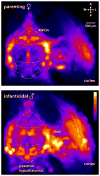The neurobiology of parenting: A neural circuit perspective
- PMID: 27921311
- PMCID: PMC5241891
- DOI: 10.1002/bies.201600159
The neurobiology of parenting: A neural circuit perspective
Abstract
Social interactions are essential for animals to reproduce, defend their territory, and raise their young. The conserved nature of social behaviors across animal species suggests that the neural pathways underlying the motivation for, and the execution of, specific social responses are also maintained. Modern tools of neuroscience have offered new opportunities for dissecting the molecular and neural mechanisms controlling specific social responses. We will review here recent insights into the neural circuits underlying a particularly fascinating and important form of social interaction, that of parental care. We will discuss how these findings open new avenues to deconstruct infant-directed behavioral control in males and females, and to help understand the neural basis of parenting in a variety of animal species, including humans. Please also see the video abstract here.
Keywords: MPOA; hormones; hypothalamus; infanticide; infants; neural circuits; neuropeptides; parenting; social behavior.
© 2016 The Authors BioEssays Published by WILEY Periodicals, Inc.
Figures





References
-
- Numan M, Insel TR. The neurobiology of parental behavior. New York: Springer-Verlag; 2003.
-
- Gubernick DJ, Alberts JR. The biparental care system of the California mouse, Peromyscus californicus. J Comp Psychol. 1987;101:169–77. - PubMed
Publication types
MeSH terms
Grants and funding
LinkOut - more resources
Full Text Sources
Other Literature Sources
Medical

